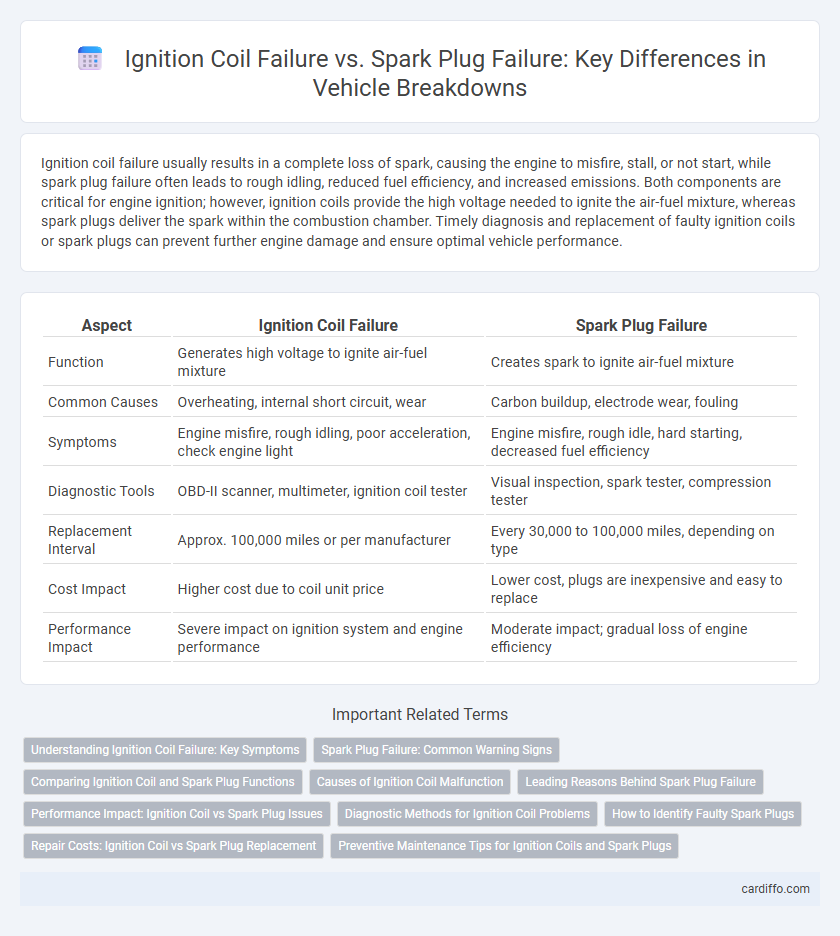Ignition coil failure usually results in a complete loss of spark, causing the engine to misfire, stall, or not start, while spark plug failure often leads to rough idling, reduced fuel efficiency, and increased emissions. Both components are critical for engine ignition; however, ignition coils provide the high voltage needed to ignite the air-fuel mixture, whereas spark plugs deliver the spark within the combustion chamber. Timely diagnosis and replacement of faulty ignition coils or spark plugs can prevent further engine damage and ensure optimal vehicle performance.
Table of Comparison
| Aspect | Ignition Coil Failure | Spark Plug Failure |
|---|---|---|
| Function | Generates high voltage to ignite air-fuel mixture | Creates spark to ignite air-fuel mixture |
| Common Causes | Overheating, internal short circuit, wear | Carbon buildup, electrode wear, fouling |
| Symptoms | Engine misfire, rough idling, poor acceleration, check engine light | Engine misfire, rough idle, hard starting, decreased fuel efficiency |
| Diagnostic Tools | OBD-II scanner, multimeter, ignition coil tester | Visual inspection, spark tester, compression tester |
| Replacement Interval | Approx. 100,000 miles or per manufacturer | Every 30,000 to 100,000 miles, depending on type |
| Cost Impact | Higher cost due to coil unit price | Lower cost, plugs are inexpensive and easy to replace |
| Performance Impact | Severe impact on ignition system and engine performance | Moderate impact; gradual loss of engine efficiency |
Understanding Ignition Coil Failure: Key Symptoms
Ignition coil failure often manifests through engine misfires, reduced fuel efficiency, and difficulty starting the vehicle, distinguishing it from spark plug issues that primarily cause rough idling and poor acceleration. Key symptoms include a noticeable drop in engine power, a check engine light triggered by misfire codes (P0300-P0312), and increased exhaust emissions due to incomplete combustion. Identifying these signs early can prevent further drivetrain damage and costly repairs.
Spark Plug Failure: Common Warning Signs
Spark plug failure commonly manifests through rough engine idling, difficulty starting the vehicle, and reduced fuel efficiency. Misfires and hesitation during acceleration are frequent indicators signaling the need for spark plug inspection or replacement. Ignoring these signs may lead to increased emissions and potential engine damage over time.
Comparing Ignition Coil and Spark Plug Functions
Ignition coils generate the high voltage needed to create a spark inside the combustion chamber, while spark plugs deliver that spark to ignite the air-fuel mixture. Failure of the ignition coil results in a weak or absent spark, leading to engine misfires and reduced performance, whereas spark plug failure typically causes inefficient combustion due to worn electrodes or fouled plugs. Understanding the distinct roles of ignition coils and spark plugs is crucial for diagnosing breakdowns related to ignition system malfunctions.
Causes of Ignition Coil Malfunction
Ignition coil failure often stems from overheating caused by excessive engine temperatures or prolonged use, leading to insulation breakdown and coil winding damage. Moisture intrusion and exposure to oil or road debris can also cause electrical shorts or corrosion, compromising coil performance. Furthermore, faulty spark plugs increase the ignition coil's workload, accelerating coil wear and precipitating failure.
Leading Reasons Behind Spark Plug Failure
Spark plug failure primarily occurs due to carbon fouling, electrode erosion, and overheating, which disrupt efficient combustion and engine performance. Ignition coil failure, by contrast, often results from electrical shorts or insulation breakdown, leading to weak or no spark generation. While ignition coils impact spark delivery, spark plug degradation directly affects ignition consistency and fuel efficiency, making understanding their failure modes critical for timely vehicle maintenance.
Performance Impact: Ignition Coil vs Spark Plug Issues
Ignition coil failure often causes significant engine misfires, reduced power, and poor fuel efficiency by disrupting the spark generation essential for combustion. Spark plug issues primarily result in rough idling, hesitation during acceleration, and decreased mileage due to incomplete combustion. Ignition coil problems tend to cause more severe performance drops and can lead to engine stalling, whereas spark plug faults generally yield milder symptoms and are easier to diagnose and replace.
Diagnostic Methods for Ignition Coil Problems
Diagnostic methods for ignition coil problems include using an ohmmeter to measure coil resistance and checking for visible signs of damage or corrosion. Employing an oscilloscope can reveal irregular spark patterns, while a spark tester confirms whether the coil produces sufficient voltage. In contrast to spark plug failure, ignition coil diagnostics often require specialized electronic testing tools to accurately pinpoint the fault.
How to Identify Faulty Spark Plugs
Faulty spark plugs can be identified by symptoms such as engine misfires, rough idling, and difficulty starting the vehicle. Visual inspection reveals worn electrodes, carbon deposits, or cracks on the plug surface. Measuring the spark plug gap and resistance with a multimeter helps confirm deterioration, distinguishing spark plug failure from ignition coil issues.
Repair Costs: Ignition Coil vs Spark Plug Replacement
Ignition coil replacement generally costs between $150 and $300 due to higher parts and labor expenses, whereas spark plug replacement is more affordable, typically ranging from $50 to $150. Spark plugs require more frequent replacement, usually every 30,000 to 100,000 miles, while ignition coils may last longer but incur greater repair costs when failures occur. Understanding these cost differences helps in budgeting for vehicle maintenance and addressing breakdowns efficiently.
Preventive Maintenance Tips for Ignition Coils and Spark Plugs
Ignition coil failure and spark plug failure can cause engine misfires and poor fuel efficiency, highlighting the importance of regular preventive maintenance. Inspect ignition coils for cracks or corrosion and replace them every 60,000 to 100,000 miles, while spark plugs require cleaning or replacement every 30,000 to 50,000 miles depending on the type. Using manufacturer-recommended parts and maintaining proper engine timing significantly reduces the risk of breakdowns and extends the lifespan of both components.
Ignition coil failure vs spark plug failure Infographic

 cardiffo.com
cardiffo.com